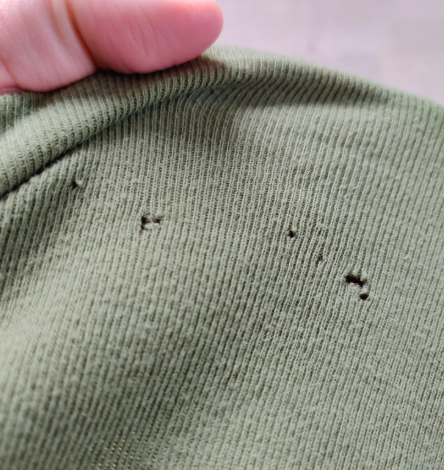
Friction Holes vs. Moth Holes: What’s the Difference?
Have you ever found small holes in your clothes around the belt line or near the waist and assumed it was due to moths? You’re not alone. Many of us have experienced this, and it can be frustrating to figure out the cause. In this post, we’ll break down the difference between friction holes and moth holes, so you can better care for your wardrobe.
What Are Friction Holes?
Friction holes are small holes that develop in your clothing due to constant rubbing against hard objects like buttons, zippers, or the edge of your trousers. Common areas where these holes appear are around the belt line or near the waistband, where your clothes rub against your belt buckle or the top of your pants. Even everyday activities like leaning against a kitchen sink or wearing a seatbelt can contribute to these holes.
This friction causes the fabric to wear down over time, eventually leading to small holes. Fabrics like cotton, soft wool blends, and delicate materials like cashmere and silk are more prone to these kinds of issues, as they are more delicate than synthetic materials like polyester, which tend to be more durable.
Why Do Friction Holes Seem More Common Now?
In the past, friction holes weren’t as prevalent. The main reason for this change is the increase in the use of delicate fabrics. While natural fibers such as cotton, silk, and wool are beautiful, they’re not as resistant to wear and tear as man-made materials. Additionally, we now wear delicate fabrics for everyday tasks—people used to reserve silk shirts for special occasions, not for cooking or doing chores.
In the past, garments were better cared for, with people using protective clothing like aprons to preserve their clothes. Today, however, we’re often wearing our favorite delicate clothes for everything, contributing to the wear-and-tear effect.
How to Prevent Friction Holes
While we won’t suggest going back to polyester, there are ways to prolong the life of your clothes and reduce the chances of friction holes. For starters, think about when you wear your best clothes. Do you really need to wear a cotton t-shirt or delicate wool sweater while doing housework? Consider wearing an apron or tucking your shirts in to protect them. You can also buy silicone covers for your jeans button to soften the impact on the fabric.
What Are Moth Holes?
Moth holes are caused by the larvae of clothes moths, which feed on natural fibers such as wool, silk, and cotton. These pests are attracted to organic materials, specifically the protein keratin found in animal fibers, and over time, they eat through the fabric, causing visible holes. You may first notice moth holes as tiny, uneven patches or small holes, often in clothing made of wool or silk.
How to Identify Clothes Moths
To check if clothes moths are responsible for the damage to your garments, start by inspecting your wardrobe thoroughly. Moths tend to hide in dark, undisturbed spaces, so check items that you don’t wear often, such as wool sweaters, coats, and even leather or suede shoes. Moths are attracted to sweat and body oils, so check the areas around the arms, neck, cuffs, and inside pockets where you might have more exposure to these substances.
If you’re unsure whether you have a moth problem, using a moth box can help. These boxes attract male moths using pheromones, so you can check for signs of moth activity in your wardrobe.
What to Do If You Find Moth Damage
If you find moths or moth holes, act quickly. Start by discarding any garments that are beyond repair. For clothes that are still salvageable, wash them thoroughly with a gentle laundry detergent or take them to the dry cleaners. You should also vacuum your entire wardrobe, paying special attention to corners and cracks where moths might hide.
To prevent future damage, use moth-repellent products like our Chrysanthemum Moth Spray to kill larvae, eggs, and adult moths. Additionally, store your clothes in protective boxes with moth-repellent sachets to keep your wardrobe safe.
Friction Holes vs. Moth Holes
If you notice holes in your clothes near the belt line, it’s a good idea to check whether moths are the cause. However, if your clothes are primarily cotton, it’s almost certainly not moths. Moths are only attracted to animal-derived fibers such as wool, silk, and leather. Since cotton and synthetic fabrics do not contain keratin, which moths feed on, they’re unlikely to be the culprit.
Another key difference is that clothes moths do not focus on one area of clothing. They feed randomly, wherever the female moth has laid her eggs. If the damage is concentrated in one area, like the waist or belt line, it’s more likely to be friction holes than moths.
Conclusion
Whether you’re dealing with friction holes or moth holes, understanding the cause of the damage can help you take better care of your wardrobe. By practicing a little extra care, like protecting delicate garments and using the right storage solutions, you can keep your clothes in excellent condition for years to come.






